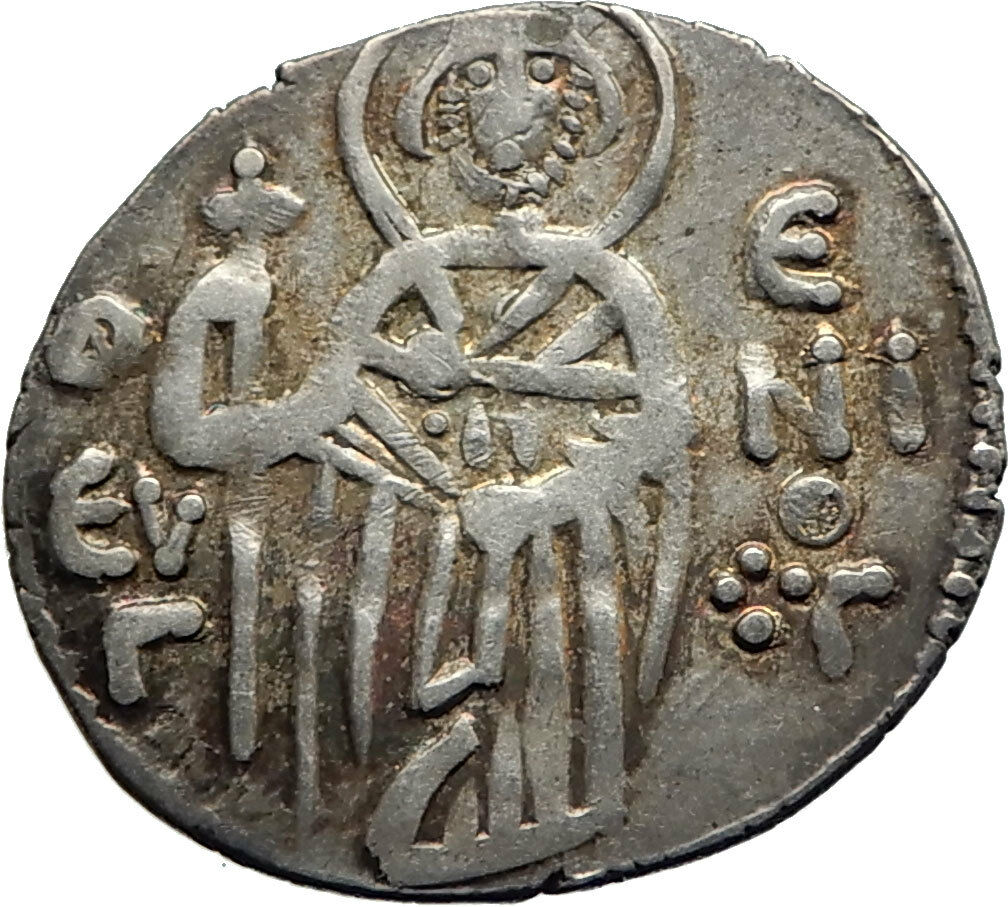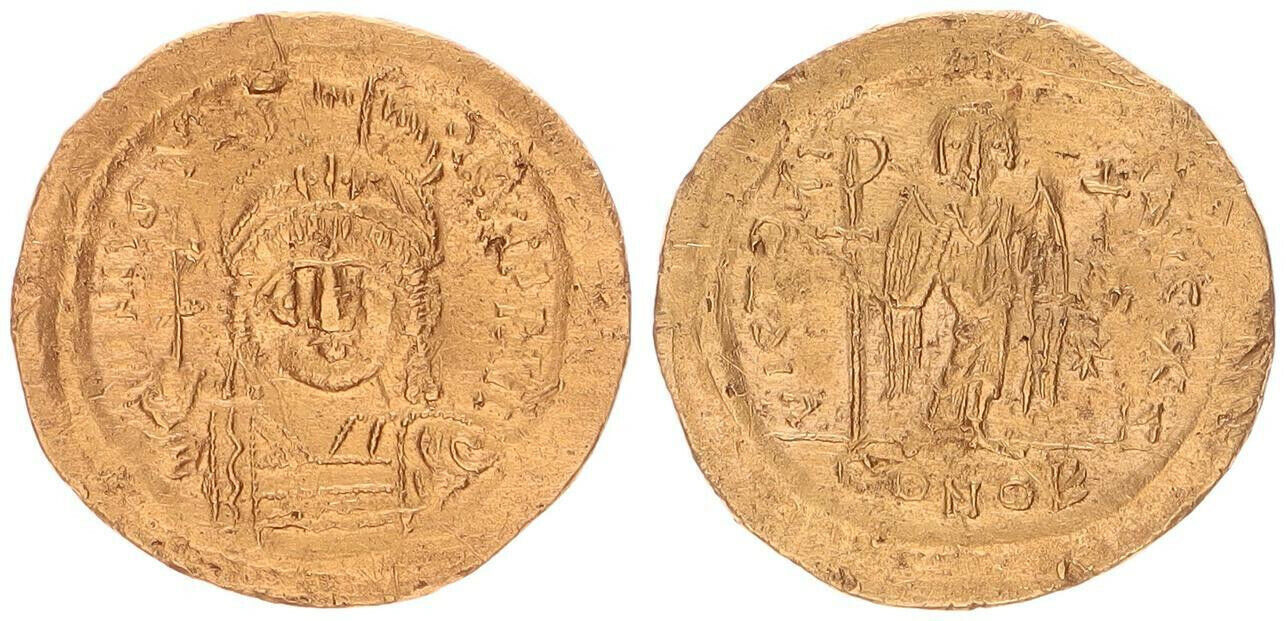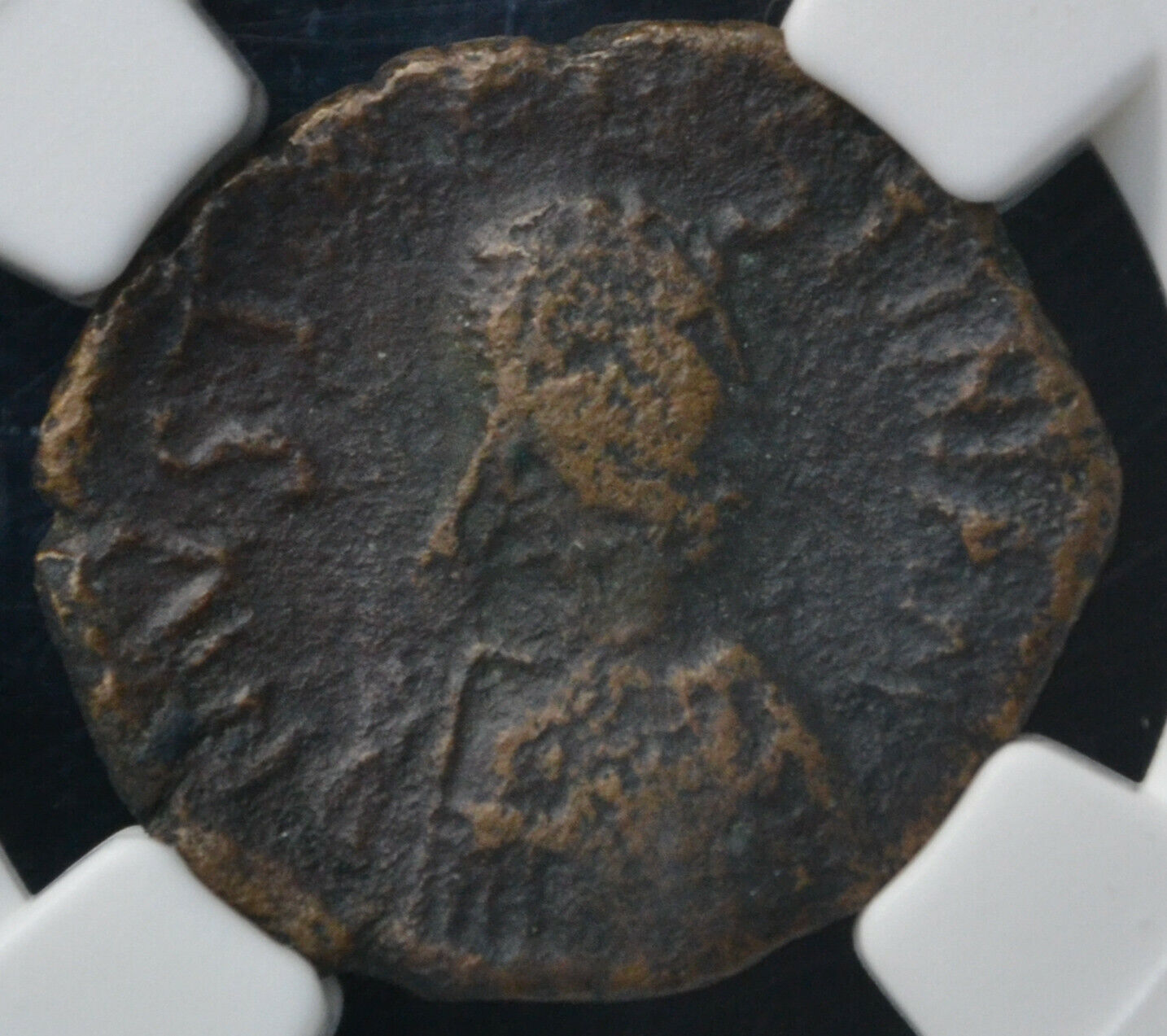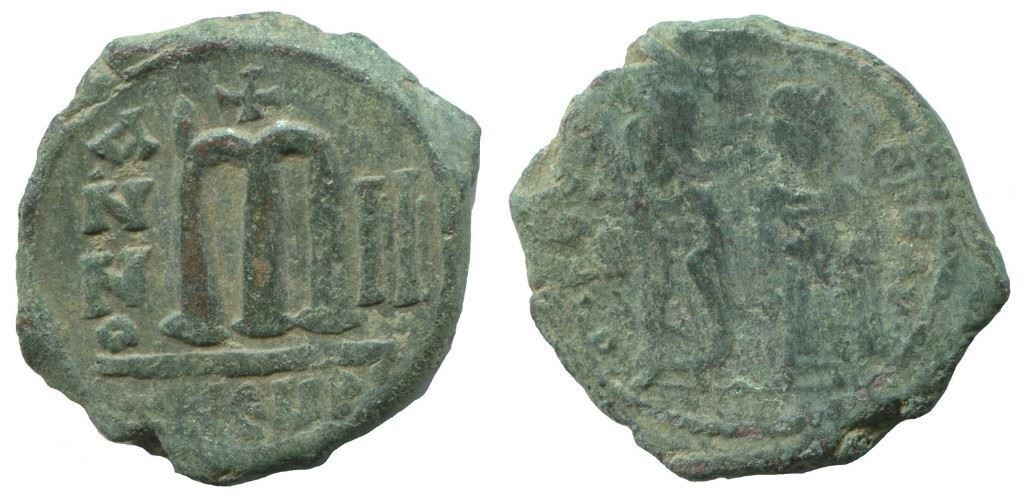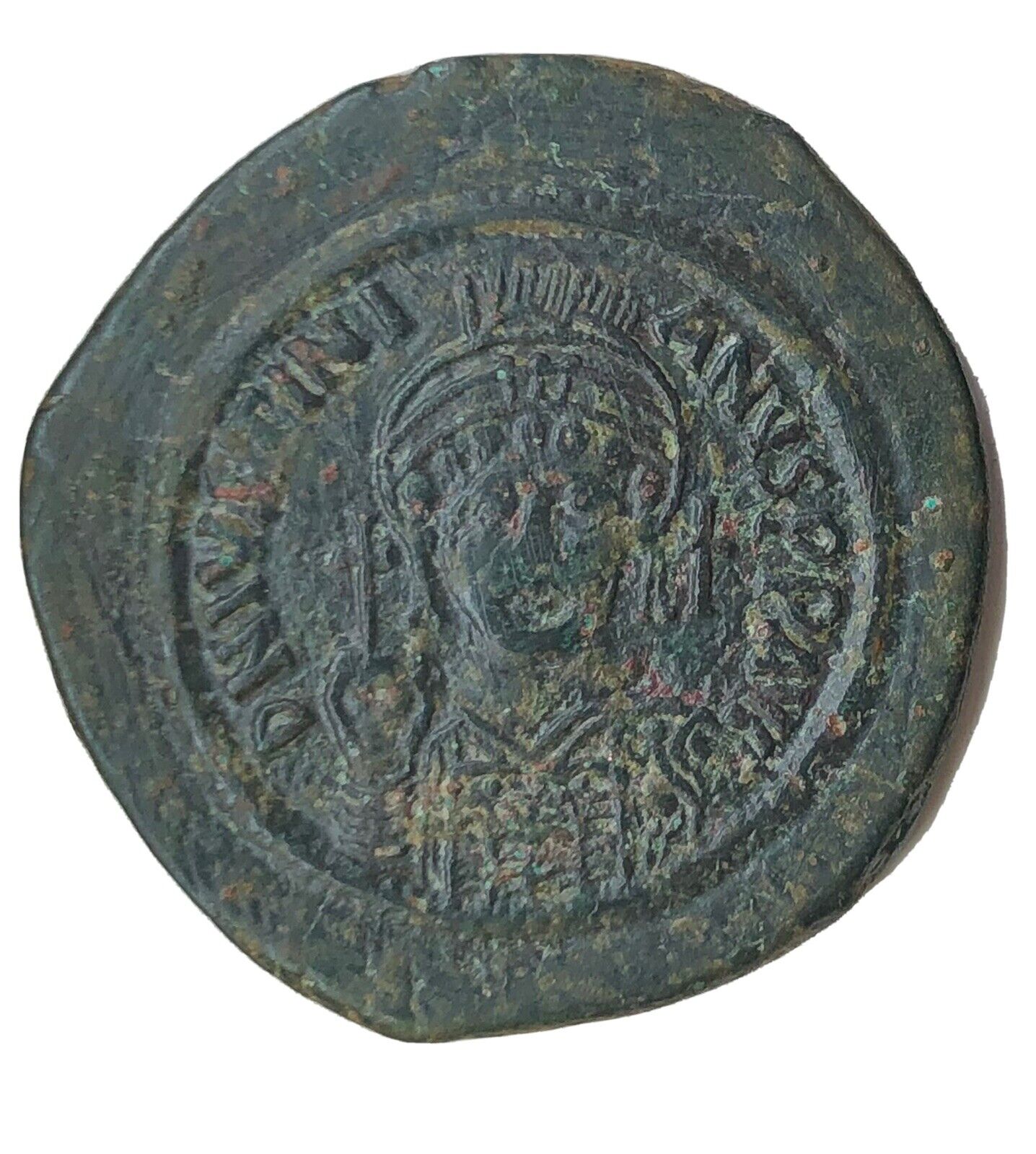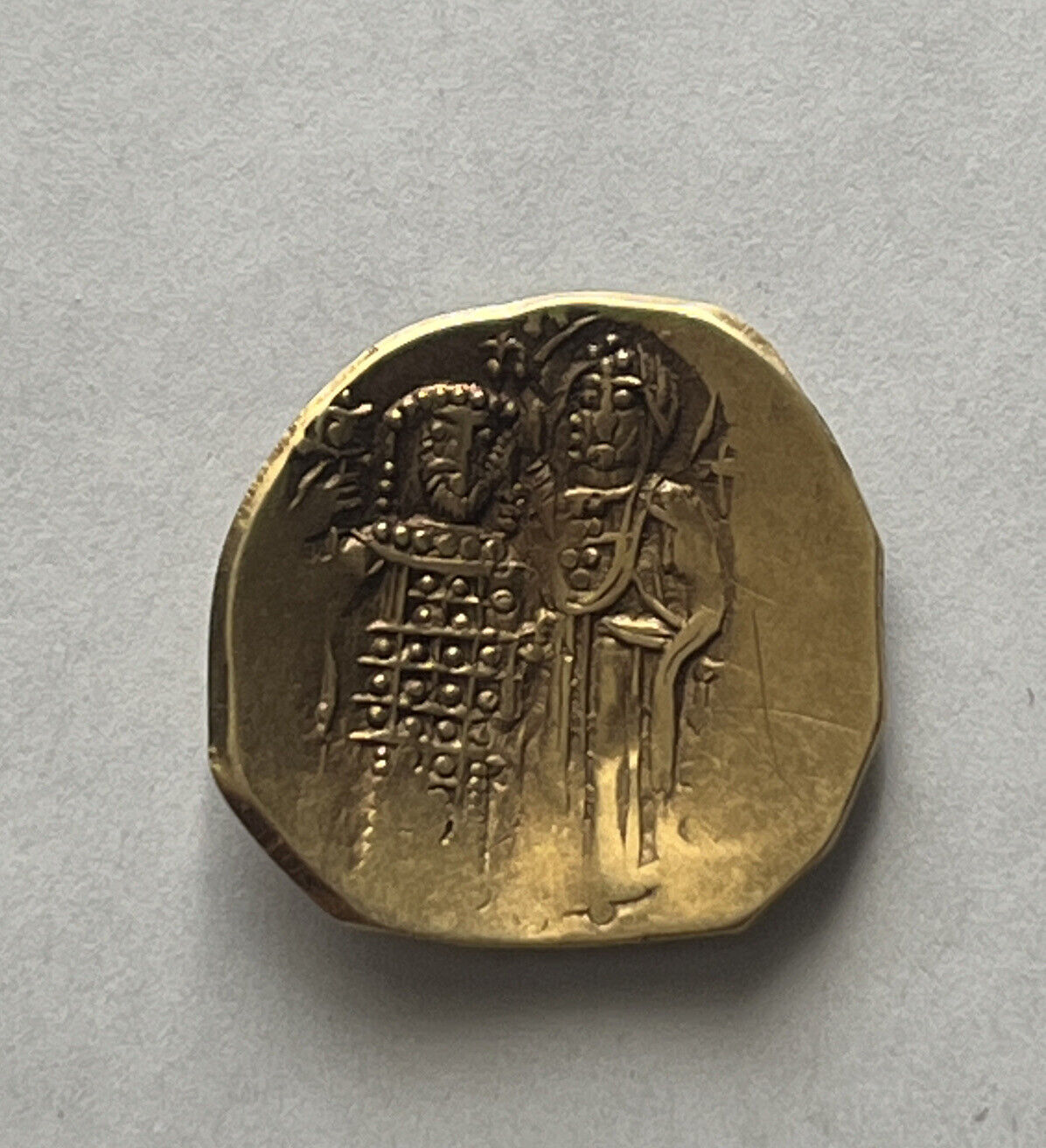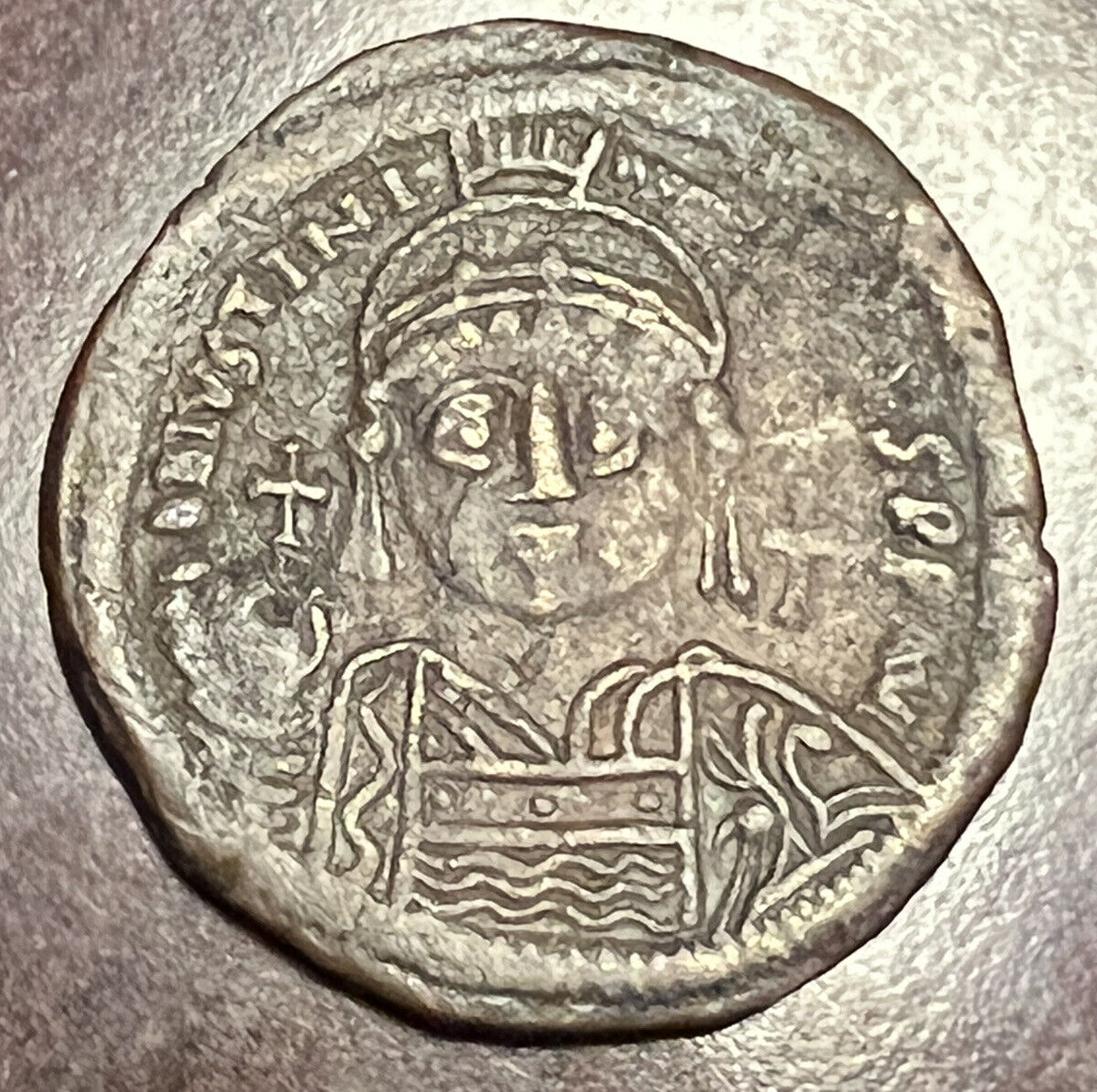-40%
JOHN II of EMPIRE of TREBIZOND Ancient Silver Byzantine Coin St Eugene i74516
$ 331.92
- Description
- Size Guide
Description
Item:i74516
Authentic Ancient Coin of:
Byzantine Empire
- The Empire of
Trebizond
John II - Emperor of Trebizond: 1280-1297 A.D.
Silver Asper 23mm (2.85 grams)
Reference: Sear 2611; Retowski 68
St. Eugenius standing right, holding long cross; cross below left arm.
John standing facing, holding labarum-headed sceptre and globe; Manus Dei to upper right.
You are bidding on the exact item pictured, provided with a Certificate of Authenticity and Lifetime Guarantee of Authenticity.
Saint Eugenios
or
Eugene
was martyred under Diocletian and a cult devoted to him developed in Trebizond. His feast day is 21 January. Eugenios along with the martyrs Candidus, Valerian and Aquila was persecuted during the reign of Diocletian (284-305) and Maximian (305-311). The four hid in the mountains above Trebizond, but were eventually found and brought before the regimental commander Lycius. They were flogged, tortured with fire and eventually beheaded. Eugenios is credited with the destruction of the image on the "gray hill" overlooking the city, later known as the Mithratis.
The Komnenian rulers of the Empire of Trebizond adopted the saint as the patron of their country. His alleged miracles include assisting Trebizond to repel a siege of the city by the Seljuk Turks in 1224. His image appears frequently on Trapezuntine coins. The cult and pilgrimage around this saint never really developed beyond Trebizond's borders, although John Lazaropoulos, Metropolitan of Trebizond in the name Joseph, collected the miracles of St. Eugenios into one book in the 14th century.
A monastery dedicated to him existed in Trebizond: Rosenqvist identifies it consisted of a structure on Mount Minthrion with an associated church, and a
metochion
inside the city walls. There is evidence that the monastery was in existence at least as early as the ninth century; a
typikon
composed in 1346 provides details of the monastic community's life.
According to the Orthodox Church in America, his prayer is thus:
"Your holy martyr Eugene, O Lord, Through his sufferings has received an incorruptible crown from You, our God.
For having Your strength, he laid low his adversaries, And shattered the powerless boldness of demons.
Through his intercessions, save our souls!
John II Megas Komnenos
(Greek: Ἰωάννης Β΄ Μέγας Κομνηνός,
Iōannēs II Megas Komnēnos
) (c. 1262 - 16 August 1297) was Emperor of Trebizond from 1280 to 1297. He was the youngest son of Emperor Manuel I and his third wife, Irene Syrikaina, a Trapezuntine noblewoman. John succeeded to the throne after his full-brother George was betrayed by his archons on the mountain of Taurezion. It was during his reign that the style of the rulers of Trebizond changed; until then, they claimed the traditional title of the Byzantine emperors, "Emperor and Autocrat of the Romans", but from John II on they changed it to "Emperor and Autocrat of all the East, the Iberians, and the Transmarine Provinces", although Iberia had been lost in the reign of Andronikos I Gidos.
John is the first ruler of Trebizond for whom we know more than a few incidents and hints; there is enough information to compose a connected narrative of the first part of his reign. The chronicle of Michael Panaretos, which is often terse and even cryptic, is relatively full for John's reign, and external sources add further details to Panaretos' account. Emperor John II faced many challenges to his rule, which partly explains his marriage to the daughter of the Byzantine emperor Michael VIII Palaiologos.
This insecurity may explain the sole instance where two Emperors of Trebizond appear on the coins of this polity: John and his oldest son, Alexios. By associating himself with his son Alexios on these coins, John may be advertising his choice for his successor.
John was born ca. 1262/3, the son of Manuel I (reigned 1238-1263) and his wife, Irene Syrikaina.
John's reign was marked from the beginning with instability. He came to the throne in June 1280, following the betrayal and death of his brother George (r. 1266-1280) by his own officials. His first recorded act as Emperor was in 1281, when he received an embassy from Michael VIII Palaiologos (r. 1259-1282) consisting of George Acropolites and a prominent churchman by the name of Xiphilinos; the goal of this mission was to convince John to discontinue using the title of "Emperor and Autocrat of the Romans". Michael had gained the throne of the Empire of Nicaea through a coup against the youthful heir John IV Laskaris some 20 years before, then gained possession of Constantinople itself from the Latin Empire, and based on this achievement Michael believed that only he had the right to this title. This was not the only reason the Byzantine emperor regarded John as a threat: some opponents of Michael's acceptance of union with the Western Church saw John as a viable Orthodox candidate for the imperial throne. Michael considered high-ranking members of the Byzantine aristocracy who refused to embrace the union as threats to his reign, and they were imprisoned, flogged, blinded, or murdered.
Michael had repeatedly petitioned John's predecessors to discontinue using the title of the traditional imperial title. When Acropolites and Xiphilinos presented the invitation of his daughter's hand in return for ceding his ancestral title, John refused this offer. John replied that he was following the precedent set by his predecessors and that the nobility of Trebizond would not allow him to renounce the traditional title.
Once Akropolites left Trebizond, John was faced with a rebellion led by one Papadopoulos, which according to Finlay gained control of the citadel and made John their prisoner. Finlay states that while it is not "possible to establish the complicity of the Byzantine agents in this business", he considers that they likely had a hand in the matter. As Finlay points out, regardless of Michael's possible machinations, "there cannot be a doubt that it [the revolt] was the cause of producing a great change in the views of the emperor of Trebizond and his court".
Following the suppression of Papadopoulos' revolt, a second embassy from Michael arrived at Trebizond, composed of Demetrios Iatropoulos,
logothetes ton oikeiakon
, and a high ecclesiastic, who offered the bargain once again. This time John agreed to the marriage, but explained it was impossible for him to lay aside the imperial title, which had been borne by his ancestors. "The title of
Basileus
, the purple boots, the robes embroidered with eagles, and the prostrations of the powerful chiefs of the aristocracy, were dear to the pride of the citizens of Trebizond, and attached them to the person of the emperors." After pledges of sincerity from Michael were made, John agreed to the marriage. However, when he reached Constantinople, his hosts induced him, before he entered the city, to lay aside his purple boots and imperial robes out of respect for Michael Palaiologos-despite the fact his future father-in-law was absent campaigning against the Turks. In exchange for this concession, Michael awarded John with the title of Despot. Michael died before the wedding took place.
While John was away at Constantinople, David VI Narin, the Georgian King of Imereti, besieged the capital. Though King David failed to take the city, the Georgians occupied several provinces. John left for Trebizond on 25 April 1282 with his new wife, Eudokia Palaiologina. Not long after John arrived home, he was confronted by two new threats to his reign. The first was from his half-brother George, who returned to Trebizond and made an unsuccessful attempt to seize the throne. Next was his half-sister Theodora, daughter of Manuel I by his Georgian wife, Rusudan, who apparently deposed him in 1284 to rule for a short time before making a "sudden flight" (in Michael Panaretos' words) from Trebizond; Michel Kuršanskis suggests he may have taken refuge in Tripolis. John was restored to the throne no later than 1285.
Panaretos, our primary source for his reign, offers us few details about the remainder of his reign. His account of John's reign-which amounts to three paragraphs-concludes with the statement that it was "during his reign the Turks seized Chalybia and launched a great invasion, so that all those places became uninhabited."
During the 1290s, the Ünye fortress on the western border of the country was built by him.
John died at Limnia in 1297. John Lazaropoulos, in his
Logos
, notes that when his son Alexios succeeded him, the western part of his realm was under heavy pressure from "the godless Agarenes" and only Kerasous, part of Chalybia, Oinaion, and "the thirteen towns or forts of Limnia" remained to the Empire; John may have been leading his forces against the enemy when he died. His body was transported to his capital and interred in the Panagia Chrysokephalos Church ("Golden-headed" Virgin). Portraits of John and his wife Eudokia could be seen in the church of St. Gregory of Nyssa, prior to its reconstruction in 1863. These portraits were notable that his robes were adorned with the single-headed eagle "the special emblem of the Comneni of Trebizond", while her robes bore the double-headed eagle of Byzantium.
Foreign policy
It was in the later half of John's reign that his Empire attracted attention from the West. For most of the 13th century, Trebizond had not been on the minds of Western leaders: for example, they had played no part in the Council of Lyons in 1274. That changed in the 1290s. Pope Nicholas IV wrote two letters in 1291 inviting John II to convert to Catholicism, join in a new crusade for the recovery of the Holy Land and be Christianity's envoy to the Mongols. The following year an English embassy to the Mongols passed through Trebizond; Anthony Bryer notes John did little for them except lend them "his palace chef to show how the local delicacies of the Empire were cooked." About this time a Genoese colony was established in Trebizond, perhaps as early as 1290, for the English embassy records meeting a merchant of Genoa, Nicolo d'Oria, in Trebizond; he may have been the Genoese consul. Also in the first years of this decade there is evidence that the Franciscans established a convent in Trebizond, which not only served as their base for evangelizing Anatolia, but provided friars to minister to the Genoese in that city.
The
Empire of Trebizond
or the
Trapezuntine Empire
was a monarchy and successor state of the Byzantine Empire that flourished during the 13th through 15th centuries, consisting of the far northeastern corner of Anatolia (the Pontus) and the southern Crimea. The empire was formed in 1204 after the Georgian expedition in Chaldia, commanded by Alexios Komnenos a few weeks before the sack of Constantinople. Alexios later declared himself Emperor and established himself in Trebizond (modern day Trabzon, Turkey). Alexios and David Komnenos, grandsons and last male descendants of deposed Emperor Andronikos I Komnenos, pressed their claims as "Roman Emperors" against Byzantine Emperor Alexios V Doukas. The Byzantine emperors, as well as Byzantine authors, such as George Pachymeres, Nicephorus Gregoras and to some extent Trapezundines such as John Lazaropoulos and Basilios Bessarion, regarded the emperors of Trebizond as the "princes of the Lazes", while the possession of these "princes" was also called Lazica, in other words, their state was known as the
Principality of the Lazes
. Thus from the point of view of the Byzantine writers connected with the Lascaris and later with the Palaiologos, the rulers of Trebizond were not emperors.
After the crusaders of the Fourth Crusade overthrew Alexios V and established the Latin Empire, the Empire of Trebizond became one of three Byzantine successor states to claim the imperial throne, alongside the Empire of Nicaea under the Laskaris family and the Despotate of Epirus under a branch of the Angelos family. The ensuing wars would see the Empire of Thessalonica, the imperial government that sprung from Epirus, collapse following conflicts with Nicaea and Bulgaria and the final recapture of Constantinople by the Empire of Nicaea in 1261. Despite the Nicaean reconquest of Constantinople, the Emperors of Trebizond would continue to style themselves as "Roman Emperors" for decades and continued to press their claim on the Imperial throne. Emperor John II of Trebizond officially gave up the Trapezuntine claim to the Roman imperial title and Constantinople itself 11 years after the Nicaeans recaptured the city, altering his imperial title from "Emperor and Autocrat of the Romans" to "Emperor and Autocrat of all the East, Iberia (i.e. Lazica) and Perateia".
The Trapezuntine monarchy would survive the longest among the Byzantine successor states. The Despotate of Epirus had ceased to contest the Byzantine throne even before the Nicaean reconquest and was briefly occupied by the restored Byzantine Empire c. 1340, thereafter becoming a Serbian dependency later inherited by Italians, ultimately falling to the Ottoman Empire in 1479. Whilst the Empire of Nicaea had restored the Byzantine Empire through restoring control of the capital, it ended in 1453 with the conquest of Constantinople by the Ottomans. Trebizond would last until 1461 when the Ottoman Sultan Mehmed II conquered it after a month-long siege and took its ruler and his family into captivity, marking the final end of the Roman imperial tradition initiated by Augustus 1,488 years previously. The Crimean Principality of Theodoro, an offshoot of Trebizond, lasted another 14 years, falling to the Ottomans in 1475.
Frequently Asked Questions
Mr. Ilya Zlobin
, world-renowned expert numismatist, enthusiast, author and dealer in authentic ancient Greek, ancient Roman, ancient Byzantine, world coins & more.
Who am I dealing with?
You are dealing with Ilya Zlobin, ancient coin expert, enthusiast, author and dealer with an online store having a selection of over 15,000 items with great positive feedback from verified buyers and over 10 years experience dealing with over 57,000 ancient and world coins and artifacts. Ilya Zlobin is an independent individual who has a passion for coin collecting, research and understanding the importance of the historical context and significance all coins and objects represent. Most others are only concerned with selling you, Ilya Zlobin is most interested in educating you on the subject, and providing the largest selection, most professional presentation and service for the best long-term value for collectors worldwide creating returning patrons sharing in the passion of ancient and world coin collecting for a lifetime.
How long until my order is shipped?
Orders are shipped by the next business day (after receipt of payment) most of the time.
How will I know when the order was shipped?
After your order has shipped, you will be left positive feedback, and that date could be used as a basis of estimating an arrival date. Any tracking number would be found under your 'Purchase history' tab.
USPS First Class mail takes about 3-5 business days to arrive in the U.S. International shipping times cannot be estimated as they vary from country to country.
Standard international mail to many countries
does not
include a tracking number, and can also be slow sometimes.
For a tracking number and signature confirmation, you may want to do Express Mail International Shipping, which costs more, however, is the fastest and most secure. Additionally you may be able to receive your order in as little as 3-5 business days using this method. For Express Mail International, it may be possible to place up to 10-15 items in one package (for the one shipping cost) as it is flat rate envelope, which may be the most cost-effective, secure and fastest way to receive items internationally. Send me a message about this and I can update your invoice should you want this method.
Getting your order to you, quickly and securely is a top priority and is taken seriously here.
Great care is taken in packaging and mailing every item securely and quickly.
Please be aware, I cannot take responsibility for any postal service delivery delays, especially for international packages as it may happen in rare instances.
What is a certificate of authenticity and what guarantees do you give that the item is authentic?
Each of the items sold here, is provided with a Certificate of Authenticity, and a Lifetime Guarantee of Authenticity, issued by a world-renowned numismatic and antique expert that has identified over 57,000 ancient coins and has provided them with the same guarantee. You will be very happy with what you get with the COA; a professional presentation of the coin, with all of the relevant information and a picture of the coin you saw in the listing. Additionally, the coin is inside it's own protective coin flip (holder), with a 2x2 inch description of the coin matching the individual number on the COA.
On the free-market such a presentation alone, can be considered a - value all in itself, and it comes standard with your purchases from me,
FREE.
With every purchase, you are leveraging my many years of experience to get a more complete context and understanding of the piece of history you are getting. Whether your goal is to collect or give the item as a gift, coins presented like this could be more prized and valued higher than items that were not given such care and attention to.
Buy a coin today and own a piece of history, guaranteed.
Is there a money back guarantee?
I offer a 30 day unconditional money back guarantee. I stand behind my coins and would be willing to exchange your order for either store credit towards other coins, or refund, minus shipping expenses, within 30 days from the receipt of your order. My goal is to have the returning customers for a lifetime, and I am so sure in my coins, their authenticity, numismatic value and beauty, I can offer such a guarantee.
When should I leave feedback?
Once you receive your order, please leave a positive feedback. Please don't leave any negative feedbacks, as it happens sometimes that people rush to leave feedback before letting sufficient time for their order to arrive. Also, if you sent an email, make sure to check for my reply in your messages before claiming that you didn't receive a response. The matter of fact is that any issues can be resolved, as reputation is most important to me. My goal is to provide superior products and quality of service.
How and where do I learn more about collecting ancient coins?
Visit the "
Guide on How to Use My Store
" for on an overview about using my store, with additional information and links to all other parts of my store which may include educational information on topics you are looking for.
